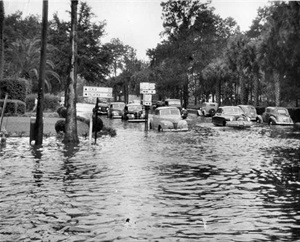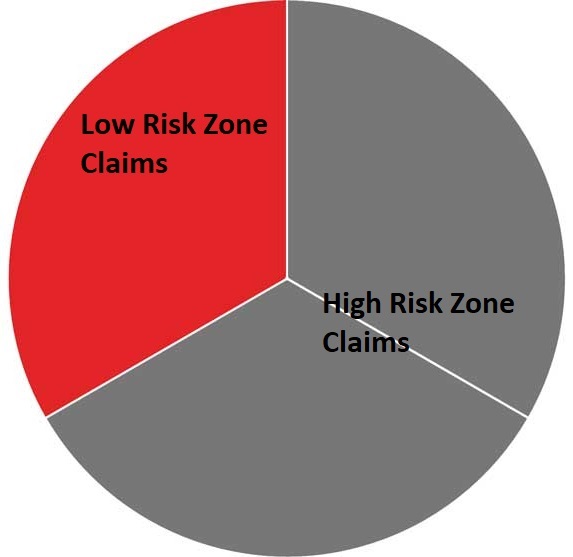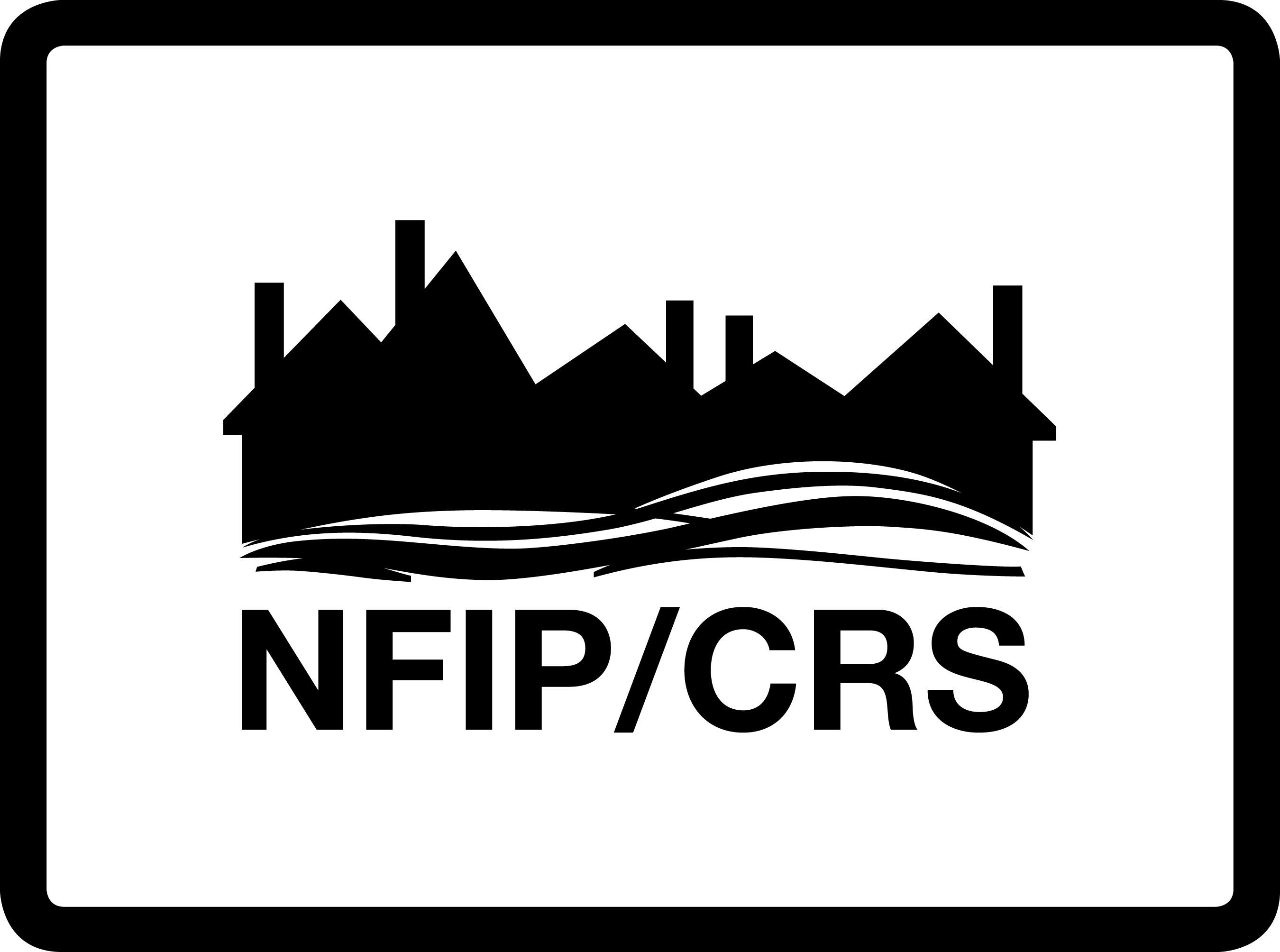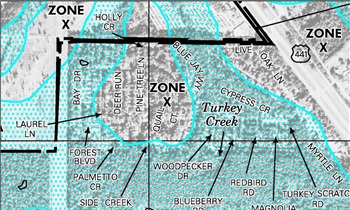If you are looking for information concerning a current emergency event, including press releases, situation reports, shelter information, and evacuations please visit the Alachua County Emergency Management home page.
Gainesville is a beautiful place to live. Its many natural creeks, lakes, and wetlands provide a wide range of benefits. Water quality is improved through wetlands and creek vegetative buffers that filter nutrients and impurities from runoff. Local waterways provide habitat for fish and wildlife. Floodplains that surround local water bodies also provide storage and conveyance of runoff from heavy rainfall that help reduce the impacts of flooding.
Lakes, creeks and wetlands not only provide valuable natural function, they also provide beautiful settings for nature parks and hiking trails as well as private homes. Since 1987, new homes and business located in floodplains have been reviewed for compliance with the Gainesville flood ordinance. In order for a community to offer flood insurance through the National Flood Insurance Program (NFIP) the community is required to enforce certain minimum regulations on development in the floodplain. This management of the floodplain is done to ensure that flooding problems do not increase and to work towards reducing the risk of flooding.
The NFIP defines a flood as "A general and temporary condition of partial or complete inundation of two or more acres of normally dry land area or of two or more properties." The City of Gainesville encompasses approximately 34,588 acres of land, and about 9,934 acres, or 23%, of that land lies within a FEMA designated flood zone.
 Most flooding in Gainesville occurs near our major water bodies which include creeks, lakes, and ponds. Major creek systems include Sweetwater Branch, Hogtown and Possum creek systems, Little Hatchet Creek, and Lake Forest Creek. Clear Lake and Newnans Lake are our two largest lakes, with Lake Alice being within the University of Florida campus.
Most flooding in Gainesville occurs near our major water bodies which include creeks, lakes, and ponds. Major creek systems include Sweetwater Branch, Hogtown and Possum creek systems, Little Hatchet Creek, and Lake Forest Creek. Clear Lake and Newnans Lake are our two largest lakes, with Lake Alice being within the University of Florida campus.
Gainesville also has significant prairie and wetland areas around the above mentioned lakes, but also including Payne’s Prairie, Hogtown Prairie, and portions of Kanapaha Prairie. These areas have also been historical locations of local flooding.
Flooding in Gainesville is historically caused by heavy rainfall, either from sustained duration, such as a tropical storm, or from severe thunderstorms that can produce localized flooding generally when the intensity of the rainfall event exceeds the capacity of the storm drain systems. These types of flooding events generally dissipate within minutes.
Gainesville’s special flood hazard areas on the Flood Insurance Rate Maps (FIRM) are currently confined to Zone A, AE zones
The National Flood Insurance Program (NFIP), administered by FEMA, was developed to provide information about the risks of flooding and to allow citizens to purchase flood insurance to protect them from the financial risks of flooding. For a homeowner, flood insurance covers structure and content losses that occur from flooding. For a renter, it covers contents. Remember that flood insurance is not included in your standard homeowner's or renter's policy. You must purchase it separately. It is sold through private insurance companies and is financially backed by the federal government. You can learn more about flood insurance at www.floodsmart.gov or by contacting your insurance agent.
Who can purchase flood insurance?
Anyone! Everyone living in the City of Gainesville, including homeowners, business owners, and renters can purchase flood insurance. This is because the city participates in the NFIP. You do not have to live in a mapped floodplain in order to purchase flood insurance, and those in a "low risk" zone are provided a "Preferred Risk Policy" for insurance.
Can flooding occur in low-risk areas?
 Yes! Nationwide, one-third of the flood loss claims are from property located outside of the mapped 1% (100-year) floodplain.
Yes! Nationwide, one-third of the flood loss claims are from property located outside of the mapped 1% (100-year) floodplain.
Just because your home is not within the mapped floodplains shown on the Flood Insurance Rate Maps does not mean that you are free from the potential risk of flooding. These maps only show areas with a higher risk of flooding from overflowing streams. Actual rainfall amounts may exceed those assumed in the computation of the mapped floodplains. Intense rainfalls can overwhelm local drainage systems causing water to pond deeply in the streets or flow overland to the nearest stream, flooding homes along the way. Smaller channels and ponds may not have been studied. The stream near your home may have a floodplain that is not shown on the Flood Insurance Rate Maps. The Flood Insurance Rate Maps are estimates using engineering technology, but nature can be unpredictable.
Does homeowners' insurance cover flood damage?
No. Flooding is not covered by standard homeowners insurance policies. Although your insurance agent might sell you your homeowners insurance policy and flood insurance, the flood insurance policy is separate and is issued through the National Flood Insurance Program.
Flood insurance is available to homeowners, renters, condo owners/renters, and commercial owners/renters. Costs vary depending on how much insurance is purchased, what it covers and the property's flood risk.
 All policy forms provide coverage for buildings and contents. However, you might want to discuss insuring personal property with your agent, since contents coverage is optional. Typically, there's a 30-day waiting period from date of purchase before your policy goes into effect.
All policy forms provide coverage for buildings and contents. However, you might want to discuss insuring personal property with your agent, since contents coverage is optional. Typically, there's a 30-day waiting period from date of purchase before your policy goes into effect.
That means now is the best time to buy flood insurance, before it is needed.
What if I rent or live in a condo?
As a tenant, you could also be impacted by a flood. Renters insurance is available! The owner may not have a insurance policy, or if they do, may not have a policy that covers contents, thus putting you at risk for great financial loss if a flood was to occur. Renters flood insurance policies are available to cover your contents, both residential and commercial, including if you live in a condo where the association owns or maintains the exterior and structure. Click here for more information or contact your agent.
What about grandfathering?
Property owners may now be required by their lender to purchase flood insurance for the first time or see their rate classification change because of the new FIRM. To help with these costs, the NFIP has 'Grandfather Rules' that recognize policy holders who have maintained continuous flood insurance coverage and those who have built in compliance with the FIRM. The date of the City of Gainesville's initial FIRM is October 3, 1971. The date of the Alachua County's initial FIRM is September 28, 1984. If a structure was built inside the city limits before October 3, 1971, it is considered to be Pre-FIRM. If you do not know the date of construction of your building, this information is usually available in the Alachua County Property Appraiser records. You can search for the construction date for a building online.
If you are an insurance professional, please read FEMA's manual covering grandfathering.
Please contact your local insurance agent for more information about flood insurance and the FEMA Grandfather Rules.

Community Rating System:
Gainesville participates in the NFIP Community Rating System, or CRS, a voluntary incentive program that recognizes and encourages community floodplain management activities that exceed the minimum NFIP requirements. Flood insurance premiums are discounted to reflect the reduced flood risk resulting from community actions. Gainesville has a class rating of 6, meaning that property owners within the City limits are entitled to a flood insurance discount of approximately 20% in Special Flood Hazard Area Zones A and AE, and a 10% discount in Non-Special Flood Hazard Area Zone X.

To view the Flood Insurance Rate Maps, log on to FEMA Map Service Center. In the upper left corner of the FEMA Map Service Center page, look for the Product Search block, and then:
- Select "Public Flood Map"
- Type in the address that you are looking for
- Click on the Search by Street Address button. (A map panel number will be listed on the next screen.)
- Click on the view button and the map will be opened for you.
Flood Insurance Rate Maps (FIRMs):
What they are. What they are not:
Many residents know that there are FEMA Flood Insurance Rate Maps for our area. And many, including those who use them on a regular basis, have a fundamental misunderstanding of these maps. Here's some information about what these maps really are, and what they are not. The FIRMs are published by FEMA to establish flood insurance rates and to assist local communities in regulating development activities. They are not depictions of which specific areas are and are not subject to flooding. In fact, the official name is "Flood Insurance Rate Map," not floodplain map.
Does this mean that the maps are inaccurate?
No, it does not. The maps define the regulatory "floodplain," and other information, based on the "estimated" flooding from an assumed amount of rainfall. It could always rain more, and history tells us that it sometimes does. Furthermore, the maps only define flooding that occurs when a creek, lake and some of our low-lying areas becomes overwhelmed. They do not define flooding when an area receives extraordinarily intense rainfall and is not able to drain quickly enough through street or roadside drainage systems. As mentioned, the regulatory floodplains are estimates of the potential for flooding. Analysis after past flood events has indicated that the estimates are, for the most part, relatively accurate; however, these estimates are only as good as the technical data upon which they are based. So, there is some generally accepted range of uncertainty in these estimates. In other words, the floodplain maps are accurate, but only to a point. They provide a reasonable depiction of higher-risk flood areas along the primary wetlands and creeks. Over time, our knowledge of the floodplain locations has improved, and occasionally, FEMA FIRMs are changed. This is typically the result of a new study that uses more current and modern data and technologies to estimate flooding and define the regulatory floodplain. New studies can result in smaller or larger 1% chance regulatory floodplains in a given area because the floodplains are more clearly defined by using the new data and technology.
Letters of Map Change:
Letter of Map Change (LOMC) is a general term used to refer to the several types of revisions and amendments to FEMA maps that can be accomplished by letter. They include Letter of Map Amendment (LOMA), Letter of Map Revision (LOMR), and Letter of Map Revision based on Fill (LOMR-F). More information concerning LOMC can be found here.
Elevation Certificates:
The Elevation Certificate is an important administrative tool of the NFIP. It is to be used to provide elevation information necessary to ensure compliance with community floodplain management ordinances, to determine the proper insurance premium rate, and to support a request for a Letter of Map Change. A copy of a blank Elevation Certificate can be obtained online from FEMA, and for regulatory and LOMC purposes, must be filled out by a State of Florida licensed and registered Professional Land Surveyor. Elevation Certificates relating to past permitted construction are also kept on file at the City of Gainesville Building Inspections office and at the Public Works Department.
NOTE: FEMA has issued a new Elevation Certificate form. As of November 2023, the old form will no longer be accepted for new Elevation Certificates.
FEMA Revalidation Letters:
When our new NFIP maps became effective on September 24, 2021, previously issued Letter of Map Change actions were automatically superseded. The Revalidation Letter provides a listing of Letters of Map Change that have been reviewed and re-validated by FEMA. The Revalidation Letter was issued on September 25th 2021. This letter revalidates previously issued LOMA's that are not reflected in the current FIRM.
FEMA_Revalidation_09252021_125107.pdf(PDF, 268KB)
FEMA sends the Revalidation letters to Local Governments only. If a property owner has a LOMC but is notified that they need to carry flood insurance, they should provide a copy of the Revalidation Letter and the original determination letter to their mortgage lender. The mortgage lender will then recognize that the property is not within a FEMA Special Flood Hazard Area. If you do not have a copy of the original determination letter, you can contact the Public Works Department at 352-334-5070 and request a copy.
MT-EZ - Letter of Map Amendment Application for a Single Residential Lot:
A Letter of Map Amendment (LOMA) is an official amendment, by letter, to an effective NFIP map. A LOMA establishes the location of the property in relation to the Special Flood Hazard Area. LOMAs are usually issued because a property has been inadvertently mapped as being in the floodplain, but is actually on natural high ground above the base flood elevation. The most common type of Letter of Map Change is a LOMA for a single residential lot that has not been elevated with fill. The application form used for this type of LOMA is called the MT-EZ. There is no application fee requirement for MT-EZ.
The following information must be attached to the MT-EZ application:
1. A report and/or letter from the City of Gainesville that provides a base flood elevation. Call the Public Works Department at 352-334-5069 to request a Flood Zone Report.
2. A copy of the FIRM that can be printed from the FEMA Map Service Center website or requested by calling the Public Works Department at 352-334-5069.
3. A copy of the subdivision plat map (This map can be printed from the Alachua County Clerk of Court website) or copy of the property deed and a property plat map.
4. A FEMA Elevation certificate that must be certified by a licensed engineer or surveyor registered in Florida.
LOMAs for multiple lots and Letter of Map Revision (LOMR), and Letter of Map Revision based on Fill (LOMR-F) involve a more complicated application process that can be researched online at FEMA. You can also call the Public Works Department at 352-334-5069 and ask for Floodplain assistance. Staff can provide you with contact information for local consultants that have experience with these types of applications.
Before a Flood:
To prepare for a flood, you should...
- Avoid building in a flood prone area unless you elevate and reinforce your home.
- Elevate the furnace, water heater, and electric panel if susceptible to flooding.
- Install "check valves" in sewer traps to prevent floodwater from backing up into the drains of your home.
- Contact community officials to find out if they are planning to construct barriers (levees, beams, floodwalls) to stop floodwater from entering the homes in your area.
- Seal the walls in your basement with waterproofing compounds to avoid seepage.
To learn more about what you can do to protect your home, we encourage you to visit FEMA's Build Safer website.
During a Flood
If a flood is likely in your area, you should...
- Listen to the radio or television for information
- Be aware that flash flooding can occur. If there is any possibility of a flash flood, move immediately to higher ground. Do not wait for instructions to move.
- Be aware of streams, drainage channels, canyons, and other areas known to flood suddenly. Flash floods can occur in these areas with or without such typical warnings as rain clouds or heavy rain.
If you must prepare to evacuate, you should do the following:
- Secure your home. If you have time, bring in outdoor furniture. Move essential items to an upper floor.
- Turn off utilities at the main switches or valves if instructed to do so. Disconnect electrical appliances. Do not touch electrical equipment if you are wet or standing in water.
If you have to leave your home, remember these evacuation tips:
- Do not walk through moving water. Six inches of moving water can make you fall. If you have to walk in water, walk where the water is not moving. Use a stick to check the firmness of the ground in front of you.
- Do not drive into flooded areas. If floodwaters rise around your car, abandon the car and move to higher ground if you can do so safely. You and the vehicle can be quickly swept away.
-Driving Flood Facts-
The following are important points to remember when driving in flood conditions:
- Six inches of water will reach the bottom of most passenger cars causing loss of control and possible stalling.
- A foot of water will float many vehicles.
- Two feet of rushing water can carry away most vehicles including sport utility vehicles (SUV’s) and pick-ups.
After a Flood
- Listen for news reports to learn whether the community's water supply is safe to drink.
- Avoid floodwaters; water may be contaminated by oil, gasoline, or raw sewage. Water may also be electrically charged from underground or downed power lines.
- Avoid moving water.
- Be aware of areas where floodwaters have receded. Roads may have weakened and could collapse under the weight of a car.
- Stay away from downed power lines, and report them to the power company.
- Return home only when authorities indicate it is safe.
- Stay out of any building if it is surrounded by floodwaters.
- Use extreme caution when entering buildings; there may be hidden damage, particularly in foundations.
- Service damaged septic tanks, cesspools, pits, and leaching systems as soon as possible. Damaged sewage systems are serious health hazards.
- Clean and disinfect everything that got wet. Mud left from floodwater can contain sewage and chemicals.
Property Protection Measures:
For those homes and business built before floodplain regulations were in effect, there are several methods available to reduce your risk of flooding. Brochures on flood proofing and other mitigation measures are available at the Alachua County Downtown Public Library. FEMA also posts many publications on their website, such as The Homeowner's Guide to Retrofitting: Six Ways to Protect Your House from Flooding.
Family Preparedness: The American Red Cross and FEMA have jointly published excellent brochures entitled "Your Family Disaster Plan" and "Your Family Disaster Supplies Kit." Every family should obtain these and follow them. They cover more than just floods and will also be useful for other potential disasters. Knowing what to do is your best protection and your responsibility. To obtain a copy of the brochures, contact the North Central Florida Chapter of the American Red Cross at 352-376-4669 or online at Alachua Redcross for related information. Additional Flood safety information can be found at www.ready.gov/floods.
Floods Awesome Power brochure
Red Cross Flood Safety Checklist
Alachua County Flood Protection Website: The City of Gainesville is within Alachua County. Alachua County maintains a Flood Hazard Information website with additional information.
Flood Threat Recognition System:
The City of Gainesville is within Alachua County, so flood threat recognition begins with Alachua County Emergency Management. They have the capability to monitor rainfall accumulations through Baron’s Mobile ThreatNet radar, local WeatherBug weather stations and various websites. These websites include the National Weather Service, the Water Management Districts and the Southeast River Forecast Center. Additionally, the County Warning Point (CWP) assists by receiving notice of flooding either from the National Weather Service, the State Watch Office or reports from citizens or emergency services personnel. Once a watch or warning is received, the County Warning Point notifies appropriate personnel and agencies through Alachua County Emergency Management, a telephonic system is used for warning the public. Alachua County has implemented the rapid notification system, Alert Alachua. This is updated weekly and tested quarterly.
If you reside or own property within the limits of Alachua County and would like to receive CodeRED emergency messages, you may sign up by clicking the below link.
IMPORTANT: USE YOUR PHYSICAL ALACHUA COUNTY ADDRESS. DO NOT USE POST OFFICE OR OUT OF TOWN ADDRESSES.
- Should you at any time desire to be removed from the calling list you may do so by calling Alachua County Emergency Management at 352-264-6500.
- To enroll in Alachua County's Alert Alachua Notification Database, visit the Alachua County Emergency Managment Page. This allows you to supply your own information creating a more accurate database and allows you to select how you want to be notified.
Alachua County Emergency Management also maintains a Twitter feed and Facebook page with up-to-date weather and flood advisories, as well as other Emergency information.
Twitter @Alachua_CO_EM
Facebook Alachua County Emergency Management
Real Time Rainfall/Runoff Data: Alachua County Emergency Management has the capability to monitor rainfall accumulations through Baron’s Mobile ThreatNet radar, local WeatherBug weather stations and various websites. These websites include the National Weather Service, the Water Management Districts and the Southeast River Forecast Center.
Current Weather and Watches/Warnings: Jacksonville National Weather Service
River Conditions: National Weather Service’s South East River Forecast Center River Conditions
River Gauge Data: Suwannee River Water Management District; Jacksonville National Weather Service - Advanced Hydrologic Prediction Service; and United States Geological Survey
1% Floodplain: Also known as the Base Flood, it is an area of land that has a 1% chance of being inundated by floodwaters in a given year.
Base Flood Elevation (BFE): This is the elevation above the average sea level that waters from a 1% flood will reach at a given point. These elevations are determined using hydrology and hydraulic computer models and then these elevations are mapped on the topographic data to produce the 1% floodplain.
Community Rating System (CRS): A voluntary incentive program of the National Flood Insurance Program that recognizes and encourages community floodplain management activities that exceed the minimum requirements. As a result, flood insurance premium rates are discounted to reflect the reduced flood risk resulting from the community actions meeting the three goals of the CRS: (1) reduce flood losses; (2) facilitate accurate insurance rating; and (3) promote the awareness of flood insurance.
Federal Emergency Management Agency (FEMA): The part of the Department of Homeland Security tasked with responding to, planning for, recovering from and mitigating against disasters.
Floodplain: Creeks, lakes and ponds naturally come out of their banks and inundate adjacent land from time to time. The area that is inundated is referred to as a floodplain.
Flood Insurance Rate Map (FIRM): Maps issued by the Federal Emergency Management Agency that shows areas that have the highest probability for flooding. These maps are used to determine if flood insurance is required and what its cost will be to the buyer.
Flood Insurance Study: A study done by engineers to determine the level of risk citizens in a certain area have with respect to the dangers of flooding. The end result of a Flood Insurance Study is flood insurance rate maps that are used to determine the cost and requirements for the purchase of flood insurance.
Floodplain Management: In order for a community to offer flood insurance through the NFIP, the community is required to enforce certain minimum regulations that regulate development in the floodplain. This management of the floodplain is done to ensure the flooding problems do not increase and to work towards the reduction in the risk of flooding. This work is performed by the community's Floodplain Administrator.
National Flood Insurance Program (NFIP): The NFIP is a program that is part of FEMA that was developed to provide information about the risks of flooding and allow citizens to purchase flood insurance to protect them from the financial risks of flooding.
Preliminary Flood Insurance Rate Map: Term given to new FIRMs that are being created, so as to distinguish them from the current FIRMs, as the Preliminary FIRMs are reviewed during the appeals process. At the conclusion of the appeals process the Preliminary FIRMs will become the official FIRM for Alachua County.
Runoff: Runoff is the water from rainfall not absorbed by the ground that flows into the local drainage system, and ultimately, streams and lakes.
Special Flood Hazard Area: An area defined on a Flood Insurance Rate Map with an associated risk of flooding.